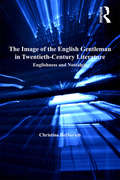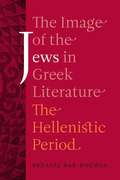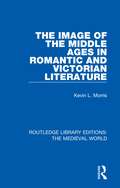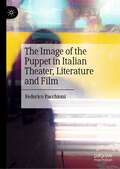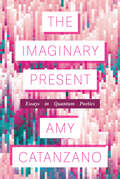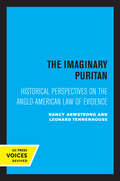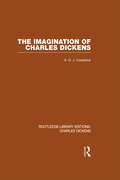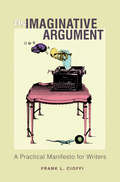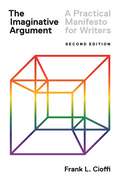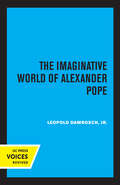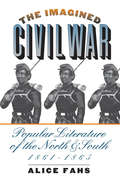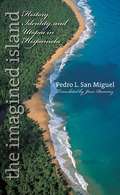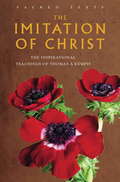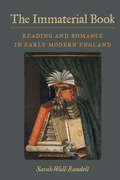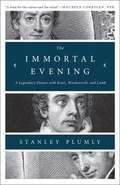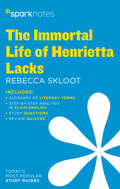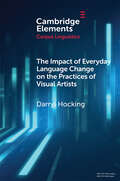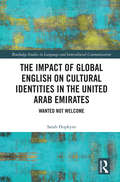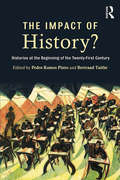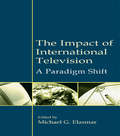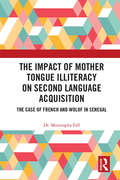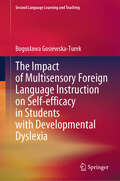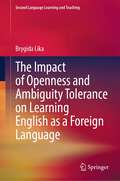- Table View
- List View
The Image of the English Gentleman in Twentieth-Century Literature: Englishness and Nostalgia
by Christine BerberichStudies of the English gentleman have tended to focus mainly on the nineteenth century, encouraging the implicit assumption that this influential literary trope has less resonance for twentieth-century literature and culture. Christine Berberich challenges this notion by showing that the English gentleman has proven to be a remarkably adaptable and relevant ideal that continues to influence not only literature but other forms of representation, including the media and advertising industries. Focusing on Siegfried Sassoon, Anthony Powell, Evelyn Waugh and Kazuo Ishiguro, whose presentations of the gentlemanly ideal are analysed in their specific cultural, historical, and sociological contexts, Berberich pays particular attention to the role of nostalgia and its relationship to 'Englishness'. Though 'Englishness' and by extension the English gentleman continue to be linked to depictions of England as the green and pleasant land of imagined bygone days, Berberich counterbalances this perception by showing that the figure of the English gentleman is the medium through which these authors and many of their contemporaries critique the shifting mores of contemporary society. Twentieth-century depictions of the gentleman thus have much to tell us about rapidly changing conceptions of national, class, and gender identity.
The Image of the Jews in Greek Literature: The Hellenistic Period
by Bezalel Bar-KochvaExamining the attitudes of Hellenistic Greek authors and scholars toward the Jewish people, and their religion and customs, over a span of 270 years, this book focuses on twelve authors from whom we have fragments and testimonials referring to the Jews.
The Image of the Middle Ages in Romantic and Victorian Literature (Routledge Library Editions: The Medieval World #37)
by Kevin L. MorrisOriginally published in 1984, The Image of the Middle Ages in Romantic and Victorian Literature looks at the impact of medievalism in the 18th and 19th centuries and the importance of post-Enlightenment literary religious medievalism. The book suggests that religious medievalism was not a superficial cultural phenomenon and that the romantic spirit with which it was chronologically connected, was intimately associated with the metaphysical. The book suggests that this belief gave birth to the metaphysical yearning and cultural expression of the eighteenth and nineteenth century. The book seeks to clarify the post-Enlightenment relationship between aesthetic culture and ‘aesthetic’ religion, romanticism, medievalism and religious trends.
The Image of the Puppet in Italian Theater, Literature and Film
by Federico PacchioniWith the advancement of cybernetics, avatars, animation, and virtual reality, a thorough understanding of how the puppet metaphor originates from specific theatrical practices and media is especially relevant today. This book identifies and interprets the aesthetic and cultural significance of the different traditions of the Italian puppet theater in the broader Italian culture and beyond. Grounded in the often-overlooked history of the evolution of several Italian puppetry traditions – the central and northern Italian stringed marionettes, the Sicilian pupi, the glove puppets of the Po Valley, and the Neapolitan Pulcinella – this study examines a broad spectrum of visual, cinematic, literary, and digital texts representative of the functions and themes of the puppet. A systematic analysis of the meanings ascribed to the idea and image of the puppet provides a unique vantage point to observe the perseverance and transformation of its deeper associations, linking premodern, modern, and contemporary contexts.
The Imaginary Present: Essays in Quantum Poetics (Poets On Poetry)
by Amy CatanzanoThe Imaginary Present by award-winning poet and professor Amy Catanzano explores cutting-edge scientific fields such as particle physics and astrophysics, and branches of physics such as quantum theory and relativity, through a poetic vision equally loyal to the imagination and rationality. Drawing upon her groundbreaking research and artist residencies at major scientific research centers like CERN and the U.S. National Science Foundation’s NOIRLab, as well as talks and poetry readings at esteemed institutions, Catanzano invites enthusiasts of poetry and science to consider what can be achieved through greater collaboration between these fields. In linked chapters that fluidly blend lyric essay, literary and scientific analysis, poetry, theory, and memoir, The Imaginary Present offers refreshing new insights on a wide range of thinkers over the past 100 years, including poets Rae Armantrout and M. NourbeSe Philip, novelists Alfred Jarry and Virginia Woolf, comic book writer Grant Morrison, and physicists Albert Einstein and Werner Heisenberg. The introduction explores why poetry and physics are capable of jointly investigating our most fundamental questions about the universe and discusses the history of the art-science connection in addition to the author’s own journey. In searching for the groundbreaking ways that artists and scientists can collaborate, The Imaginary Present offers readers both reasoned grounding and poetic framing for an interdisciplinary poetics and praxis based on science.
The Imaginary Puritan: Literature, Intellectual Labor, and the Origins of Personal Life (The New Historicism: Studies in Cultural Poetics #21)
by Nancy Armstrong Leonard TennenhouseNancy Armstrong and Leonard Tennenhouse challenge traditional accounts of the origins of modern Anglo-American culture by focusing on the emergence of print culture in England and the North American colonies. They postulate a modern middle class that consisted of authors and intellectuals who literally wrote a new culture into being. Milton's Paradise Lost marks the emergence of this new literacy. The authors show how Milton helped transform English culture into one of self-enclosed families made up of self-enclosed individuals. However, the authors point out that the popularity of Paradise Lost was matched by that of the Indian captivity narratives that flowed into England from the American colonies. Mary Rowlandson's account of her forcible separation from the culture of her origins stresses the ordinary person's ability to regain those lost origins, provided she remains truly English. In a colonial version of the Miltonic paradigm, Rowlandson sought to return to a family of individuals much like the one in Milton's depiction of the fallen world. Thus the origin both of modern English culture and of the English novel are located in North America. American captivity narratives formulated the ideal of personal life that would be reproduced in the communities depicted by Defoe, Richardson, and later domestic fiction. This title is part of UC Press's Voices Revived program, which commemorates University of California Press’s mission to seek out and cultivate the brightest minds and give them voice, reach, and impact. Drawing on a backlist dating to 1893, Voices Revived makes high-quality, peer-reviewed scholarship accessible once again using print-on-demand technology. This title was originally published in 1992.
The Imagination of Charles Dickens: Routledge Library Editions: Charles Dickens Volume 3 (Routledge Library Editions: Charles Dickens)
by A. O. CockshutThis book describes Charles Dickens as an ordinary man who by being perfectly tuned to the public taste developed into a master of his art. The clue to this paradox lies, in the author’s opinion, in Dickens’ obsession with such topics as money, crowds and prisons which touch the life of everyone. From the deep fears of his childhood they became the main food for his imagination. As his creative mind worried over them, so his art developed. This process provided the driving force behind his work, and is at the root of his greatness as an artist.
The Imaginative Argument: A Practical Manifesto for Writers
by Frank L. CioffiMore than merely a writing text, The Imaginative Argument offers writers instruction on how to use their imaginations to improve their prose. Cioffi shows writers how they can enliven argument--the organizing rubric of all persuasive writing--by drawing on emotion, soul, and creativity, the wellsprings of imagination. While Cioffi suggests that argument should become a natural habit of mind for writers, he goes still further, inspiring writers to adopt as their gold standard the imaginative argument: the surprising yet strikingly apt insight that organizes disparate noises into music, that makes out of chaos, chaos theory. Rather than offering a model of writing based on established formulas or templates, Cioffi urges writers to envision argument as an active parsing of experience that imaginatively reinvents the world. Cioffi's manifesto asserts that successful argument also requires writers to explore their own deep-seated feelings, to exploit the fuzzy but often profoundly insightful logic of the imagination. But expression is not all that matters: Cioffi's work anchors itself in the actual. Drawing on Louis Kahn's notion that a good architect never has all the answers to a building's problems before its physical construction, Cioffi maintains that in argument, too, answers must be forged along the way, as the writer inventively deals with emergent problems and unforeseen complexities. Indeed, discovery, imagination, and invention suffuse all stages of the process. The Imaginative Argument offers all the intellectual kindling that writers need to ignite this creativity, from insights on developing ideas to avoiding bland assertions or logical leaps. It cites exemplary nonfiction prose stylists, including William James, Ruth Benedict, and Erving Goffman, as well as literary sources to demonstrate the dynamic of persuasive writing. Provocative and lively, it will prove not only essential reading but also inspiration for all those interested in arguing more imaginatively more successfully.
The Imaginative Argument: A Practical Manifesto for Writers - Second Edition
by Frank L. CioffiMore than merely a writing text, The Imaginative Argument offers writers instruction on how to use their imaginations to improve their prose. Cioffi shows writers how they can enliven argument—the organizing rubric of all persuasive writing—by drawing on emotion, soul, and creativity, the wellsprings of imagination. While Cioffi suggests that argument should become a natural habit of mind for writers, he goes still further, inspiring writers to adopt as their gold standard the imaginative argument: the surprising yet strikingly apt insight that organizes disparate noises into music, that makes out of chaos, chaos theory.Rather than offering a model of writing based on established formulas or templates, Cioffi urges writers to envision argument as an active parsing of experience that imaginatively reinvents the world. Cioffi's manifesto asserts that successful argument also requires writers to explore their own deep-seated feelings, to exploit the fuzzy but often profoundly insightful logic of the imagination.But expression is not all that matters: Cioffi's work anchors itself in the actual. Drawing on Louis Kahn's notion that a good architect never has all the answers to a building's problems before its physical construction, Cioffi maintains that in argument, too, answers must be forged along the way, as the writer inventively deals with emergent problems and unforeseen complexities. Indeed, discovery, imagination, and invention suffuse all stages of the process.The Imaginative Argument offers all the intellectual kindling that writers need to ignite this creativity, from insights on developing ideas to avoiding bland assertions or logical leaps. It cites exemplary nonfiction prose stylists, including William James, Ruth Benedict, and Erving Goffman, as well as literary sources to demonstrate the dynamic of persuasive writing. Provocative and lively, it will prove not only essential reading but also inspiration for all those interested in arguing more imaginatively more successfully.This edition features new chapters that cover the revision process in greater depth, as well as the particular challenges of researching and writing in the digital age, such as working with technology and avoiding plagiarism. The book also includes new sample essays, an appendix to help instructors use the book in the classroom, and much more.
The Imaginative World of Alexander Pope
by Leopold Damrosch Jr.This title is part of UC Press's Voices Revived program, which commemorates University of California Press’s mission to seek out and cultivate the brightest minds and give them voice, reach, and impact. Drawing on a backlist dating to 1893, Voices Revived makes high-quality, peer-reviewed scholarship accessible once again using print-on-demand technology. This title was originally published in 1987.
The Imagined Civil War
by Alice FahsIn this groundbreaking work of cultural history, Alice Fahs explores a little-known and fascinating side of the Civil War--the outpouring of popular literature inspired by the conflict. From 1861 to 1865, authors and publishers in both the North and the South produced a remarkable variety of war-related compositions, including poems, songs, children's stories, romances, novels, histories, and even humorous pieces. Fahs mines these rich but long-neglected resources to recover the diversity of the war's political and social meanings.Instead of narrowly portraying the Civil War as a clash between two great, white armies, popular literature offered a wide range of representations of the conflict and helped shape new modes of imagining the relationships of diverse individuals to the nation. Works that explored the war's devastating impact on white women's lives, for example, proclaimed the importance of their experiences on the home front, while popular writings that celebrated black manhood and heroism in the wake of emancipation helped readers begin to envision new roles for blacks in American life. Recovering a lost world of popular literature, The Imagined Civil War adds immeasurably to our understanding of American life and letters at a pivotal point in our history.
The Imagined Island
by Pedro L. San MiguelIn a landmark study of history, power, and identity in the Caribbean, Pedro L. San Miguel examines the historiography of Hispaniola, the West Indian island shared by Haiti and the Dominican Republic. He argues that the national identities of (and often the tense relations between) citizens of these two nations are the result of imaginary contrasts between the two nations drawn by historians, intellectuals, and writers. Covering five centuries and key intellectual figures from each country, San Miguel bridges literature, history, and ethnography to locate the origins of racial, ethnic, and national identity on the island. He finds that Haiti was often portrayed by Dominicans as "the other--first as a utopian slave society, then as a barbaric state and enemy to the Dominican Republic. Although most of the Dominican population is mulatto and black, Dominican citizens tended to emphasize their Spanish (white) roots, essentially silencing the political voice of the Dominican majority, San Miguel argues. This pioneering work in Caribbean and Latin American historiography, originally published in Puerto Rico in 1997, is now available in English for the first time.
The Imitation of Christ
by Stephan MackennaThe saintly Thomas à Kempis's classic guide to the spiritual and religious life. A book which has been loved and revered by devout Christians throughout the ages. Transcending all sectarian divisions, it emphasises the importance of the inward journey.
The Imitation of Christ
by Stephan MackennaThe saintly Thomas à Kempis's classic guide to the spiritual and religious life. A book which has been loved and revered by devout Christians throughout the ages. Transcending all sectarian divisions, it emphasises the importance of the inward journey.
The Imitation of Christ
by Stephan MackennaThe saintly Thomas à Kempis's classic guide to the spiritual and religious life. A book which has been loved and revered by devout Christians throughout the ages. Transcending all sectarian divisions, it emphasises the importance of the inward journey.
The Immaterial Book: Reading and Romance in Early Modern England
by Sarah Wall-RandellIn romances--Renaissance England's version of the fantasy novel--characters often discover books that turn out to be magical or prophetic, and to offer insights into their readers' selves. The Immaterial Book examines scenes of reading in important romance texts across genres: Spenser's Faerie Queene, Shakespeare's Cymbeline and The Tempest, Wroth's Urania, and Cervantes' Don Quixote. It offers a response to "material book studies" by calling for a new focus on imaginary or "immaterial" books and argues that early modern romance authors, rather than replicating contemporary reading practices within their texts, are reviving ancient and medieval ideas of the book as a conceptual framework, which they use to investigate urgent, new ideas about the self and the self-conscious mind.
The Immortal Evening: A Legendary Dinner with Keats, Wordsworth, and Lamb
by Stanley PlumlyA window onto the lives of the Romantic poets through the re-creation of one legendary night in 1817. The author of the highly acclaimed Posthumous Keats, praised as "full of . . . those fleeting moments we call genius" (Washington Post), now provides a window into the lives of Keats and his contemporaries in this brilliant new work. On December 28, 1817, the painter Benjamin Robert Haydon hosted what he referred to in his diaries and autobiography as the "immortal dinner." He wanted to introduce his young friend John Keats to the great William Wordsworth and to celebrate with his friends his most important historical painting thus far, "Christ's Entry into Jerusalem," in which Keats, Wordsworth, and Charles Lamb (also a guest at the party) appeared. After thoughtful and entertaining discussions of poetry and art and their relation to Enlightenment science, the party evolved into a lively, raucous evening. This legendary event would prove to be a highlight in the lives of these immortals. A beautiful and profound work of extraordinary brilliance, The Immortal Evening regards the dinner as a lens through which to understand the lives and work of these legendary artists and to contemplate the immortality of genius.
The Immortal Life of Henrietta Lacks SparkNotes Literature Guide (SparkNotes Literature Guide Series)
by SparkNotesCreated by Harvard students for students everywhere, SparkNotes give you just what you need to succeed in school: Complete Plot Summary and AnalysisKey Facts About the WorkAnalysis of Major CharactersThemes, Motifs, and SymbolsExplanation of Important QuotationsAuthor&’s Historical ContextSuggested Essay Topics25-Question Review QuizThe Immortal Life of Henrietta Lacks features explanations of key themes, motifs, and symbols including: humanity; immortality and legacy; scientific racism; racialized poverty; hela cells; red nail polish. It also includes detailed analysis of these important characters: Deborah Lacks; Henrietta Lacks; Rebecca Skloot; George Gey.
The Impact of Everyday Language Change on the Practices of Visual Artists (Elements in Corpus Linguistics)
by Darryl HockingThe practices of visual artists can never be decontextualised from language. Firstly, artists are constantly in dialogue with their peers, dealers, critics, and audiences about their creative activities and these interactions impact on the work they produce. Secondly, artists' conceptualisations of what artistic practice encompasses are always shaped by wider social discourses. These discourses, however, and their manifestation in the language of everyday life are subject to continual change, and potentially reshape the way that artists conceptualise their practices. Using a 235,000-word diachronic corpus developed from artists' interviews and statements, this Element investigates shifts in artists' use of language to conceptualise their art practice from 1950 to 2019. It then compares these shifts to see if they align with changes in the wider English lexicon and whether there might be a relationship between everyday language change and the aesthetic and conceptual developments that take place in the art world.
The Impact of Global English on Cultural Identities in the United Arab Emirates: Wanted not Welcome (Routledge Studies in Language and Intercultural Communication)
by Sarah HopkynsThis book provides a nuanced portrait of the complexities of the cultural and linguistic landscape in the United Arab Emirates, unpacking the ever shifting dynamics and attitudes between and about English and Arabic in the region in today’s era of superdiversity.// Employing a qualitative phenomenological approach which draws on a rich set of data from questionnaires and focus groups comprising both Emirati and expatriate students and teachers, Hopkyns problematizes the common binary East-West paradigm focused around the tension between the use of English and Arabic in the UAE. Key issues emerging from the resulting analysis include the differing attitudes toward English and in particular, English Medium Instruction, the impact of this tension on identity, and the ways in which the two languages are employed in distinct ways on an everyday scale. // The volume will be of particular interest to students and scholars interested in issues around language and identity, language policy and planning, multilingualism, translanguaging, and language and education.
The Impact of History?: Histories at the Beginning of the 21st Century
by Bertrand Taithe Pedro Ramos PintoDriven by the increasing importance of discussions around 'impact' and its meaning and implications for history, The Impact of History? brings together established and new voices to raise relevant questions, issues and controversies for debate. The chapters are articulated around the themes of public history, the politics of history, the role of history in the shaping of learning and the situation of history in the changing world of education. While this subject is driven differently by the research bodies and councils of different countries, similar debates about the value and place of the academy in society are taking place in the UK, the USA and Europe as well as in other parts of the world. Chapters cover diverse areas of history from this perspective including: public history national histories new technologies and the natural sciences campaigning histories the impact agenda. This collection is a political and intellectual intervention at a time when scholars and readers of history are being asked to explain why history matters and it seeks to intervene in the debates on ‘impact’, on education and on the role of the past in the shaping of our future. Bringing together leading authors from a wide range of fields, The Impact of History? is an accessible and engaging yet polemical and thought-provoking overview of the role of history in contemporary society.
The Impact of International Television: A Paradigm Shift (Routledge Communication Series)
by Michael G. ElasmarFor several decades, cultural imperialism has been the dominant paradigm for conceptualizing, labeling, predicting, and explaining the effects of international television. It has been used as an unchallenged premise for numerous essays on the topic of imported television influence, despite the fact that the assumption of strong cultural influence is not necessarily reflected in the body of research that exists within this field of study. In The Impact of International Television: A Paradigm Shift, editor Michael G. Elasmar and his contributors challenge the dominant paradigm of cultural imperialism, and offer an alternative paradigm with which to evaluate international or crossborder message influence. In this volume, Elasmar has collected original research from leading scholars working in the area of crossborder media influence, and contributes his own meta-analysis to examine what research findings actually show on the influences of crossborder messages. The contributions included here illustrate points, such as: the contentions of cultural imperialism and the context in which its assumptions emerged and developed; the complexities of the relationship between exposure to foreign television and its subsequent effects on local audience members; the applicability of quantitative methods to a topic commonly tackled using argumentation, critical theory, and other qualitative approaches; and the difficulty of achieving strong and homogenous effects. In bringing together the work of independent researchers, The Impact of International Television: A Paradigm Shift bridges over 40 years of research efforts focused on imported television influence, the results of which, as a whole, challenge the de facto strong and homogenous effects assumed by those who support the paradigm of cultural imperialism. The volume sets a theory-driven agenda of research and offers an alternative paradigm for the new generation of researchers interested in international media effects. As such, the volume is intended for scholars, researchers, and students in international and intercultural communication, cross-cultural communication, mass communication, media effects, media and society, and related areas. It will also be of great interest to academics in international relations, cross-cultural and social psychology, intergroup and international relations, international public opinion, and peace studies.
The Impact of Mother Tongue Illiteracy on Second Language Acquisition: The Case of French and Wolof in Senegal (Routledge Research in Language Education)
by Moustapha FallThis text illustrates the crucial role of the mother tongue literacy in second language acquisition by presenting findings from a comparative study conducted in primary schools in Senegal. In addition, the volume provides an in-depth look at the linguistic history of Senegal before, during, and after French colonialism. The Impact of Mother Tongue Illiteracy on Second Language Acquisition discusses the socio-linguistic landscape and ethnolinguistic composition of Senegal and its effect on the second language acquisition. An in-depth analysis of children’s phonological awareness, decoding, and reading comprehension in French reveals significant disparities in the literacy skills of Wolof children who have been exposed to Arabic and Qur’anic texts prior to schooling, and those who have not. In doing so, the text explores the impacts of post-colonial language policies in Africa, highlights the pedagogical consequences of mother tongue illiteracy, and questions the use of French as the only language of instruction in Senegalese schools. This detailed research text will of great interest and use to graduate and postgraduate students, researchers, academics, professionals and policy makers in the field of Second Language Acquisition, Multicultural Education, Applied Linguistics, French language education and, Language Policy and Planning.
The Impact of Multisensory Foreign Language Instruction on Self-efficacy in Students with Developmental Dyslexia (Second Language Learning and Teaching)
by Bogusława Gosiewska-TurekThis book investigates the effect of multisensory instruction on self-efficacy among students with developmental dyslexia learning English as a foreign language. The first three chapters of the book delve into theoretical aspects of developmental dyslexia, multisensory instruction, and self-efficacy, providing an overview of existing research in this domain. The second part of the book reports empirical findings obtained from a case study supplemented by quantitative analysis. These findings highlight the advantages of employing multisensory instructional techniques for teaching foreign languages to students with dyslexia. Notably, the application of multisensory instruction not only enhances dyslexic students’ foreign language competencies but also positively impacts their self-efficacy. The study underscores the importance of language instruction tailored to the special educational needs of students with dyslexia as well as its potential to foster self-efficacy, an essential factor for success in foreign language learning.
The Impact of Openness and Ambiguity Tolerance on Learning English as a Foreign Language (Second Language Learning and Teaching)
by Brygida LikaThis book highlights the importance of individual learner differences in learning English as a foreign language and reports the findings of a study which investigated the impact of two personality traits, which are, openness to experience and ambiguity tolerance, on target language attainment among Polish secondary school students. The book provides an exhaustive overview of the theoretical issues and existing research related to personality, emphasizing the two traits under investigation, openness, and ambiguity tolerance, which are the focus of the empirical study reported later in the book. The empirical investigation explored relationships between openness to experience and ambiguity tolerance, as well as their impact on attainment in learning English as a foreign language. Moreover, it also aimed to shed light on the link between these traits and students’ assessments (i.e., self-assessment and school grades). The findings of the study provide a basis for proposing specific profiles of foreign language learners with different levels of openness and ambiguity tolerance.
